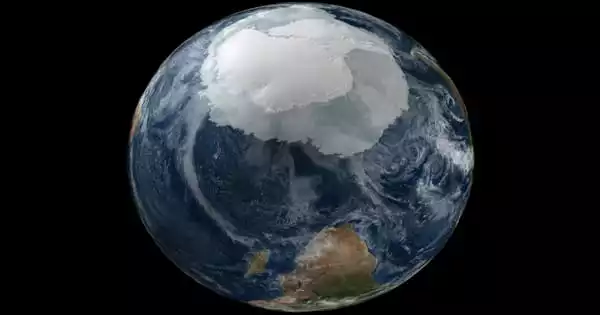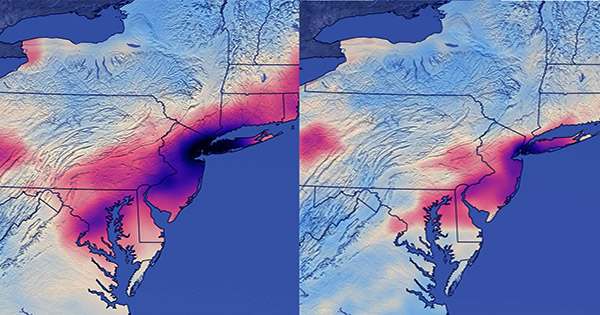This year, a massive ozone hole has formed over Antarctica. The ozone hole, which is already larger than the entire ice-covered continent, has surpassed the size of 75% of ozone holes measured since 1979 and is still growing. Climate change, according to scientists, could be the culprit.
At ground level, ozone is a pollutant, but at high levels in the atmosphere’s ‘ozone layer,’ it absorbs harmful ultraviolet radiation. Previous research has looked at ozone levels in the Southern Hemisphere, but little is known about the molecule’s long-term levels in Antarctica. Researchers analyzed more than 25 years of Antarctic data and discovered that concentrations near the ground were caused by both natural and human-caused sources.
On October 7, the 2021 Antarctic ozone hole reached its maximum area, making it the 13th largest since 1979. NASA and NOAA scientists reported that this year’s ozone hole developed similarly to last year’s: A colder-than-normal Southern Hemisphere winter resulted in a deep and larger-than-average ozone hole, which is expected to last into November or December. Researchers from the American Chemical Society’s Environmental Science & Technology journal analyzed more than 25 years of Antarctic data and discovered that concentrations near the ground arose from both natural and human-related sources.
The researchers compiled ozone data from eight Antarctica stations measured between 1992 and 2018 at ground level and through the atmosphere, from the lower atmosphere into the ozone layer. This is a large ozone hole due to colder-than-average 2021 stratospheric conditions, and it would have been much larger without the Montreal Protocol.
Paul Newman
“This is a large ozone hole due to colder-than-average 2021 stratospheric conditions, and it would have been much larger without the Montreal Protocol,” said Paul Newman, chief scientist for Earth sciences at NASA’s Goddard Space Flight Center.
While temperatures on the planet’s surface rise, the stratosphere, which houses the planet’s protective ozone shield, cool. The stratosphere, a layer of the Earth’s atmosphere ranging in altitude from 6.5 to 30 miles (10 to 50 kilometers), is where polar stratospheric clouds form in the winter. Scientists now understand that these clouds provide the ideal chemical environment for harmful chlorine and bromine-based substances to do their destructive work. They also understand that the colder the stratosphere, the more polar stratospheric clouds form.
Ozone gas has a sharp or acrid odor that is sometimes associated with smog or summer storms. It forms when sunlight reacts with gases produced by industrial and transportation activities, biomass burning, or naturally occurring gases such as lightning and microorganisms. When the sun shines brightly, the molecule is broken down. The ozone layer, an atmospheric band within the stratosphere that protects the Earth from harmful UV radiation, contains the majority of the ozone.

However, ozone in the lower atmosphere, or troposphere, is harmful, causing smog as well as throat and lung irritation. It’s also a source of concern because the molecule traps heat 1,000 times better than carbon dioxide and, as a result, has the potential to significantly contribute to global warming. While previous studies have shown an increase in ozone in the troposphere across the Southern Hemisphere, there has not been a long-term regional study for the remote Antarctic continent. As a result, Jayanarayanan Kuttippurath and colleagues wanted to use measurements taken over Antarctica to figure out where the ozone comes from and how levels have changed over time.
The researchers compiled ozone data from eight Antarctica stations measured between 1992 and 2018 at ground level and through the atmosphere, from the lower atmosphere into the ozone layer. According to their findings, the amount of ozone in the troposphere was lowest in December, January, and February, which corresponds to summer in the Southern Hemisphere when the sun is strong enough to break apart more ozone than it creates.
Natural sources of ozone included snow-pack on the large plateau in Eastern Antarctica and air mixing from the upper stratosphere to the troposphere, as well as humans, with some coming from the southern tip of South America. The researchers also discovered that ozone at ground level increased at a rate of 0.14 ppb per year over the 26-year period studied, even when seasonal and natural patterns were taken into account. Because of the ozone’s ability to hold heat near the Earth’s surface, the researchers believe the rising trend will have a negative impact on the region in the future.
Scientists predicted that the ozone layer would fully recover by 2060 when the Montreal Protocol was signed, according to Peuch. Recent measurements, however, indicate that the healing process is slowing and that a full recovery could not be expected before 2070. Climate change isn’t entirely to blame; some countries continue to use and release prohibited substances illegally.
















